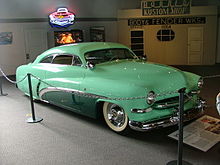This article needs attention from an expert in Automobiles. The specific problem is: Attention is needed from an expert in classic American customs and lead sleds to verify the information in the article and provide more reliable sources. (April 2024) |

A lead sled is a standard production automobile with a body heavily modified in particular ways[citation needed][dubious ](see below); especially, though not exclusively, a 1949, 1950, or 1951 model year Ford 'Shoebox' or Mercury Eight car. In the name, "lead" (as in the heavy metal) refers to the use of lead as a bodyfiller in early days, and "sled" refers to the lowering of the vehicle, giving these vehicles the appearance that they were "slip sliding" down the highway.
Period auto body repair, by an auto body mechanic used to be achieved through a combination of re-shaping sheet metal using specialist hand tools and the application of molten lead to damaged body panels, fulfilling the role of more modern polyester fillers.
The same techniques were also used in high end low-volume car production (coachbuilding) and adopted for aftermarket hot rodding body panel modifications.
Given that lead is toxic, the effective management of health hazards arising from autobody work with this material must include the exposure realms of fumes and dusts.[1]
The term as originally coined, and still appropriately applying, to large heavy V-8 powered period American performance automobiles - distinguished by their size, mass, and straight-line acceleration rather than cornering performance or braking ability - was drafted into the aviation realm to describe aircraft with similar characteristics (having nothing whatsoever to do with the long list of dubious allegedly necessary attributes itemized below).
- ^ "4.0 Controlling the Lead Hazard". Ontario Ministry of Labour, Training and Skills Development. Retrieved 2021-10-05.
© MMXXIII Rich X Search. We shall prevail. All rights reserved. Rich X Search
